by Margaret Sgarra, contemporary art curator
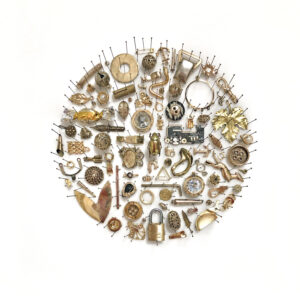
Alice Padovani, after a degree in Philosophy and Visual Arts, worked for several years in contemporary theater as actress and director, developing her own path as a visual artist and performer. She has exhibited in personal, collective and museum exhibitions on a national and international level, receiving numerous awards and recognitions. Her works are part of some important private and public collections in Italy and abroad.
Your artistic research touches upon different themes which are expressed through works identifiable as complex multi-material installations that are always unique. When and where does your project start? And when do you think it came to fruition?
My projects begins and proceed in two different ways. In the first case, I think about them, draw them, describe them, look for the materials. But actually the work is already completed when all the addends have found the right place in my head. Afterwards it’s just a matter of putting meticulous manual work into practice. Secondly, instead, I happen to come across it by chance, in the error. This can happen when a work has just begun, or when a work has been completed. This eventuality, which also happens with large-scale works, always leads me to review the project, transforming it in relation to the event that made it momentarily unstable and fragile. This uncertainty gave rise to magnificent discoveries that allowed me to find solutions I would never have arrived at.
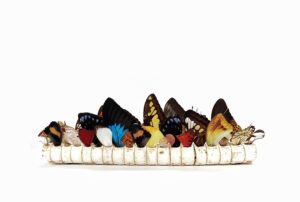
Inside your works there are parts or multitudes of insects. What do they represent for you and what meaning do you attribute to them?
My father is an entomologist, so I have always seen these animals as something familiar, emotional I would say. From a scientific point of view they are beings so distant from us, both in terms of evolution and form, that they often represent the other, what is frightening. This represents, even conceptually, the most interesting aspect of my work. Insects, unlike humans, whose “imperfection” is the reason for their constant mutation, have already been perfect beings for millions of years. They have always generated contrasting feelings that oscillate from fear to wonder, and seem to be the perfect witnesses to convey authentic curiosity towards what is considered different.
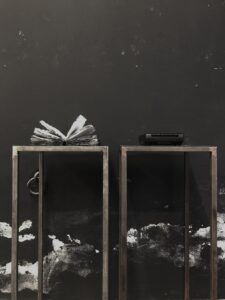
In The Cut, currently exhibited as part of Dentro i miei vuoti at F’ART in L’Aquila, connects the natural sphere with the emotional one. Can you tell us how this work was born?
Like the other works in the exhibition, this one also speaks of abandonment, absence, lack. As chance would have it, during a walk in the mountains, I found this semi-exposed root which reminded me terribly of a human pelvis. It was a piece of wood abandoned to the elements and, obviously, I recovered it and put it back in order always with the aim that it was not only a pelvis, but it was the pelvis of a woman with her vulva open and exposed. In this case I played with the idea of the black hole that is scary, just as a woman who shows off her sexual desire is scary. Sex, understood as an organ, becomes dangerous. Beetles that tend to be repulsive emerge from it and, metaphorically, insects represent the idea of death. The insect is in fact one of the best-known protagonists of the decomposition of matter. In this case they are beetles that look like jewels. Therefore a duality on wonder and repulsion, as well as a duality of the vulva as a generator of life, but at the same time an object of death.
Among the colors that can be found in your research is gold. Does it have a particular meaning?
For me, gold has always and only had the value of sacredness. For me, gilding a dead trunk is like applying a sort of funerary and sacred mask to it at the same time. In my eyes gold becomes the shining splendor of death, like a certainty. A shining death and therefore more acceptable, poetic. On the other hand, we were born to die.
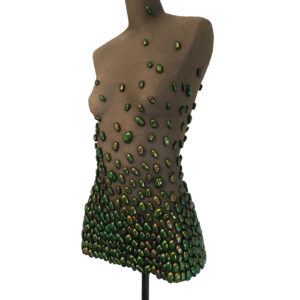
When did you understand that you would be an artist? And who are the artists who inspire you?
I think I’ve always known it: the arts in general would have been the obsession-vocation of my life. I went through it in different periods and ways, but always with the same “hunger”. The years of classical music studies, the years as a director and actress within experimental theater companies: everything was part of a unique path. At this moment this kaleidoscopic path has led me to the visual arts, but I do not exclude that it could become something else in the future. There are many artists that I love and follow and probably some of these have even unconsciously influenced some works. But my main sources of inspiration come from nature and science. From interests and readings that are apparently distant from the arts and humanities. But, in fact, it is only appearance. When we think about quantum physics, a few things are as poetic as some of the theories and phenomena they seek to explain.
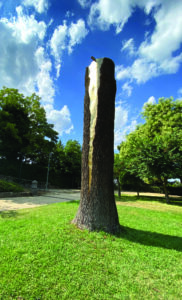
Do you wonder about the reactions that your works can arouse in the public and what type of emotion do you look for in this interaction?
I usually start from personal emotions and pains which then lead to other perspectives. The work, outside of me, is already something different, it has already become the personal emotion of a spectator. Spectators often identify very closely with the original feeling that gave life to the work, when it comes to performance art. With obvious exceptions. In the more “static” works I have noticed that one’s own interpretation is more normal. I certainly really like discovering the effect that some works in particular arouse. Sometimes the same work evokes wonder, sometimes repulsion. And the views are both right.
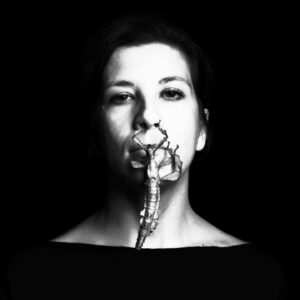
What are your next projects?
Both 2024 and 2025 will see several personal, collective and some beautiful artistic residencies. On March 2nd there will be the opening of the collective exhibition “Dentro i mie occhi” at the F’ART gallery in L’Aquila. An artistic residency will follow between the 14th and the 25th in the village of Armento (a path resulting from the Porta Coeli Foundation 404 award of the Mediterranean Art Prize) with the production and acquisition of the work created during the days of the residency which will also see a two-person exhibition organised. In April in Milan during the days of MiArt and the Salone del Mobile I will be part of Così lontano, così vicino, a collective exhibition at the M|45 space of Marco Bertoli art consulting. Finally, again in April, in collaboration with Andrea Lo Savio’s D406 gallery, some of my new watercolor and drawing works will be part of the Biennale del Disegno of Rimini. I wouldn’t like to go on any longer, except to say that the months to come will be truly intense and full of events, including personal exhibitions and residencies won thanks to the ArteamCup award.